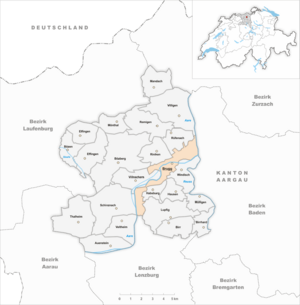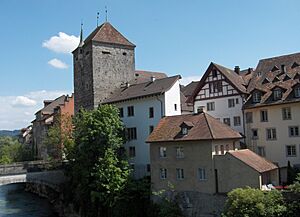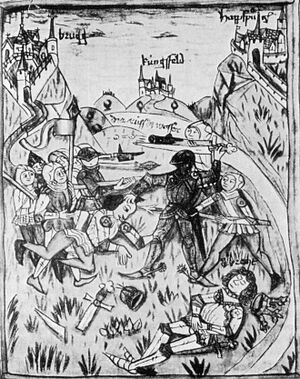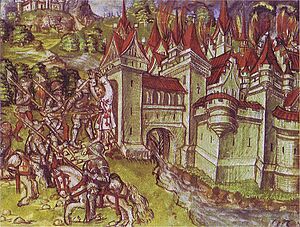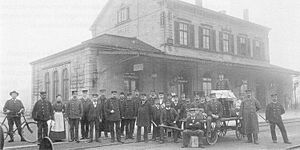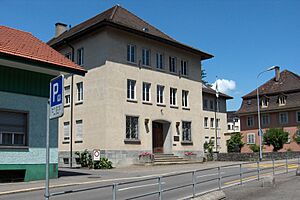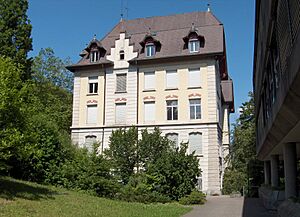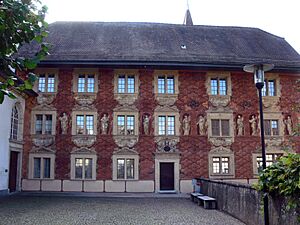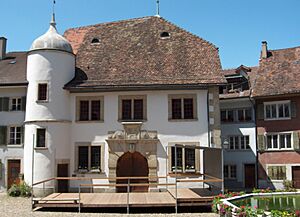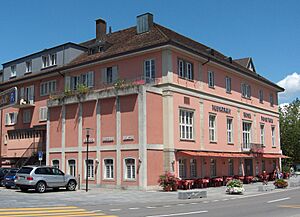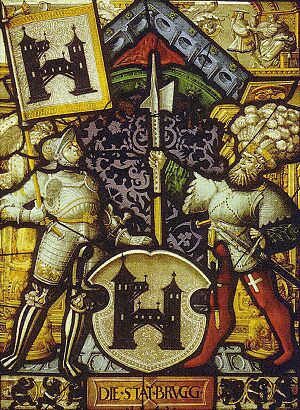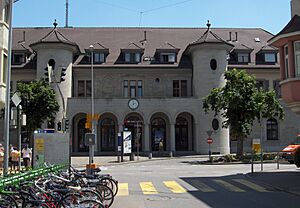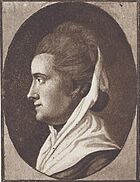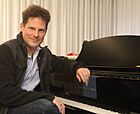Brugg facts for kids
Quick facts for kids
Brugg
|
||
|---|---|---|
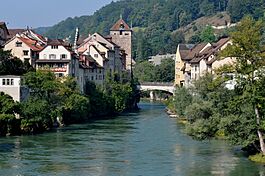 |
||
|
||
| Country | Switzerland | |
| Canton | Aargau | |
| District | Brugg | |
| Area | ||
| • Total | 8.26 km2 (3.19 sq mi) | |
| Elevation
(Alte Aarebrücke)
|
340 m (1,120 ft) | |
| Highest elevation
(Bruggerberg)
|
516 m (1,693 ft) | |
| Lowest elevation
(Aare)
|
328 m (1,076 ft) | |
| Population
(Dec 2020 )
|
||
| • Total | 12,738 | |
| • Density | 1,542.1/km2 (3,994.1/sq mi) | |
| Demonym(s) | German: Brugger(in) | |
| Postal code |
5200 Brugg, 5116 Schinznach Bad, 5222 Umiken (5235 Rüfenacht)very small part only
|
|
| Localities | Brugg, Schinznach Bad, Umiken, Altenburg, Lauffohr | |
| Surrounded by | Gebenstorf, Habsburg, Hausen, Holderbank, Lupfig, Riniken, Rüfenach, Schinznach, Untersiggenthal, Villigen, Villnachern, Veltheim, Windisch | |
| Twin towns | Rottweil (Germany) | |
Brugg is a town and municipality in Switzerland. It is located in the canton of Aargau. Brugg is known for being where three important rivers meet: the Aare, Reuss, and Limmat. The Aare river flows right through the old part of the town.
The name "Brugg" means "bridge" in Swiss German. This is because the town was built in the Middle Ages at the narrowest point of the Aare river. This made it a perfect spot for a bridge. The Habsburgs, a famous royal family, had their oldest known home nearby in Altenburg. Brugg was once the center of their lands before they moved to Austria. Later, from 1415 until 1798, Brugg was part of the territory controlled by Bern. Since then, it has been part of the Aargau canton.
Today, Brugg is home to the Swiss Farmers' Union. It also has a campus of the University of Applied Sciences and Arts Northwestern Switzerland. The Vindonissa museum in Brugg is a very important historical site. The Swiss army also has an engineer training unit based here.
Contents
Brugg's Location and Landscape
The town of Brugg stretches about six kilometers (4 miles) from southwest to northeast. It is only about one kilometer (2/3 mile) wide at its widest point. The Aare river flows through the middle of the old town. It divides the area into two different landscapes. On the south side, you find the flat Swiss plateau. On the north side, the Jura mountain range begins.
The southwestern part of Brugg has a flat area called the Wildischachen. This is a flood plain between the Aare river and a hill. On this hill, the Habsburg castle was built in the nearby community of Habsburg. Further north, two parts of the Aare river come together near Altenburg village. Between these two river branches is a forested island called Schacheninsel.
The Aare river then turns from north to east and flows into a narrow gorge. Here, the river narrows from about 130 meters (425 feet) to just 12 meters (39 feet). This is where the historic center of Brugg was built, right by the old bridge. The old town grew on both sides of the river. Today, the south bank has many homes and factories. The north bank has less development because of the steep Bruggerberg mountain (516 meters or 1,693 feet).
After leaving the gorge, the Aare river widens again. To the east, three major Swiss rivers meet: first the Reuss joins the Aare, and then the Limmat joins them about 1.5 kilometers (1 mile) downstream. The village of Lauffohr is also part of Brugg. It is located in the northeastern part of town.
How Brugg's Area Grew
For a long time, Brugg was very small, only about one-tenth of its current size. The town started to grow in 1823 when it bought land from the nearby community of Lauffohr. More land was bought from Umiken in 1827. In 1863, Windisch sold the area around the train station to Brugg.
The village of Altenburg became part of Brugg in 1901. In 1970, the rest of Lauffohr joined Brugg. More recently, on January 1, 2010, the municipality of Umiken merged with Brugg. On January 1, 2020, Schinznach Bad also became part of Brugg.
Brugg's Past
Early History
We don't have many ancient findings from Brugg. A few stone tools from the Stone Age and a sickle from the Bronze Age are all that have been found.
Around 58 BC, the Helvetii people founded a settlement called Vindonissa on a hill nearby. Later, the Romans built a military camp there around 15 BC. They built the first wooden bridge over the Aare river as part of a Roman road. This was the only place between Lake Thun and the Rhine where the river could be crossed with a single log. Many Roman graves have been found in Brugg, showing it was an important area.
Around 370 AD, the Romans built a fort in Altenburg. However, the Romans left between 401 and 406 AD. Later, the Alemanni people settled here in the 7th century.
In the late 900s, a noble family led by Lanzelin settled in Altenburg. He made the Roman fort into Altenburg Castle, his home. Around 1020, Lanzelin's son, Radbot, built Habsburg Castle a few kilometers away. This family later took the castle's name, becoming the famous Habsburgs. Altenburg was their first known home. By gaining control of this land, the Habsburgs started their powerful empire.
Under Habsburg Rule
The name Bruggo was first written down in 1064. The town was later called Brucca and Brukke. At the end of the 1100s, the Black Tower was built by Count Albrecht III. This tower is the oldest building still standing in Brugg's old town today.
In the 1200s, the settlement near the fortified river crossing grew into a small town. They started making coins in 1232 and collecting tolls in 1273. The town had a mayor by 1278. Brugg was very important to the Habsburgs, who moved their main home here between 1220 and 1230.
Rudolf I, who later became King of the Romans, gave Brugg special city rights on July 23, 1284. This made Brugg an independent town. Even though the Habsburgs moved their main power to Vienna later, they stayed connected to Brugg.
On May 1, 1308, King Albrecht I was murdered by his nephew in nearby Windisch. To honor him, his wife founded Königsfelden Abbey (King's Field Cloister) in 1310–11, very close to Brugg. Albrecht's daughter, Agnes of Hungary, moved to Königsfelden in 1317. She helped the abbey become very successful.
Conflicts and Changes
In 1415, Frederick IV lost favor with the Holy Roman Emperor. As a result, Emperor Sigismund asked the Swiss to take control of Aargau. Bern quickly sent troops. The people of Brugg did not fight back and let the Bernese enter the town. Because of this, Bern left the town unharmed.
Brugg then became part of Bern's territory. This change caused some problems for Brugg's economy. The town's location at the edge of Bern's land meant less trade.
In 1443, King Frederick III of the Habsburg family joined with Zürich in a war. He wanted his lands in Aargau back. The people of Brugg hoped the Habsburgs would return, as it might help their economy. On July 29, 1444, Brugg was attacked by a small group of soldiers. They ransacked homes and set some on fire. Many citizens were taken for ransom. This event became known as the "Brugg Night of Murder."
In 1460, Bern took full control of the surrounding areas. This meant all residents of Brugg were now subjects of Bern. However, the town's economy still struggled. The population of Brugg was cut in half after the "Brugg Night of Murder."
Under Bern's Rule
Brugg had a special status under Bern. It had more freedom than other towns. The town was governed by two mayors and a "Small City Council." There was also a "Large Council" to keep the Small Council in check. These positions were often held by a few powerful families.
In 1528, Bern decided to join the Reformation. The areas around Brugg voted to break away from the Catholic Church. Brugg itself voted to stay Catholic, but it was alone in this. Under pressure from Bern, Brugg eventually became Protestant.
The town's school, which had been around since 1396, became a state-run Latin school. It prepared students for theological studies in Bern. This school produced many priests and scholars, leading people to call Brugg the "Prophet Town."
During a plague in 1541, about 180 people died, which was a quarter of the town's residents. By 1611, the population grew to 930. The worst plague hit from 1667 to 1669, killing 514 people, over 60 percent of the population.
Artisans and craftsmanship were important jobs in Brugg. They served the local area and travelers. The salt trade also grew in the 1700s. The Salt House, built in 1732, was one of the largest salt storage places in Switzerland.
When the French Revolution began, many in Brugg supported ideas of equality. In 1798, French troops entered Switzerland. A revolutionary committee took power in Brugg. On April 12, 1798, the Helvetic Republic was declared.
The 1800s
Under the new government, Brugg lost its special privileges and became a district capital in the canton of Aargau. The revolutionary mood changed quickly in 1799 due to the War of the Second Coalition. French soldiers were housed in Brugg. After Napoléon Bonaparte signed the Act of Mediation in 1803, Brugg officially became a district capital in the new Aargau canton.
In the early 1800s, Brugg became a center for Liberalism. The town's moat was filled in 1811, and its old walls were removed between 1829 and 1840. The main road through the old town was also leveled in 1836 to make travel easier.
Brugg's leaders focused on traditional trades like handicraft and trade. They were slow to develop industry. This helped nearby towns like Windisch and Turgi grow their factories instead.
The first railway line reached Brugg in 1856. At first, the railway hurt the town's economy because fewer travelers used the old road. Brugg also had issues with the train station's location, which was technically in Windisch. In 1863, Windisch sold the land around the train station to Brugg.
With more rail lines built, Brugg became an important rail hub. The Bözbergbahn to Basel opened in 1875. Despite good transport links, industrial growth was still slow. In 1864, a printing press opened. A new water system was built in 1882, and a sewage system began in 1896.
The town's military history started in 1848 when an engineer corps was based in Brugg. Barracks were built in 1856 and a new complex in 1898.
The 1900s
Industrial growth finally took off in 1892 with the opening of the town's electric plant. Many factories moved to Brugg, leading to an economic boom. The town soon felt too small. In 1901, the canton of Aargau merged smaller communities into larger ones. Altenburg, despite voting against it, was merged into Brugg on January 1, 1901. This doubled Brugg's size.
Even though farming was not a big part of Brugg's economy, the town became known as the "Farmers Metropolis." A training school for farmers opened in 1887. The Swiss Farmers' Union moved its headquarters to Brugg from Bern. This small farmers' office grew into one of the largest interest groups in Switzerland. Cattle trade also became important after the railroad was built. The Market Hall became a major national trading center by 1930.
Catholics, whose numbers grew with new factory workers, were allowed to build their own church in 1907. The town's gas works opened in 1911. The economic boom ended during World War I. The global economic depression also hit Brugg hard, causing high unemployment.
After World War II, Brugg had another period of fast economic growth for three decades. Large development plans were made, but most were never built. Only the shopping centers Neumarkt I (1975) and Neumarkt II (1982) were completed. A bypass road, finished in 1980, helped reduce traffic in the old town.
The 2000s
Brugg became an important place for higher education starting in the late 1950s. A women's school opened in 1958, training teachers. This school later became the College of Education. The cantonal technical college opened in nearby Windisch. Both schools then merged into the University of Applied Sciences Northwestern Switzerland. There are plans to build a new, single campus for these schools by 2010.
Brugg's district hospital closed in 2003 due to money problems. This caused a big protest with over 6,000 people. The hospital became a nursing home, and 300 jobs were lost. This ended a long history of medical care in Brugg, which began with a hospital in 1450.
Because Brugg and Windisch have grown together, there were talks about merging the two towns. In 2006, people voted against the merger, mainly because of differences in tax rates and Windisch's debt. However, Brugg did merge with Umiken on January 1, 2010, after a strong "yes" vote from both towns in 2008.
Interesting Places to Visit
Important Heritage Sites
Several places in Brugg are listed as important national heritage sites. These include the Schlössli Altenburg (an old Roman and medieval castle), the former Lateinschule (Latin school), the Swiss Reformed City Church, the Schwarzer Turm (Black Tower), the Vindonissa-Museum, and the Zimmermannhaus (Carpenter House).
The Old Town
Brugg's old town is built along a narrow gorge of the Aare river. It has two parts, one on each side of the river. The larger part is on the south bank. Most of the old town's buildings are made from limestone. Only parts of the old town walls are still standing.
The oldest building and symbol of the town is the Schwarze Turm (Black Tower). It is 25.7 meters (84 feet) tall. This tower was partly built using remains from the Roman camp of Vindonissa. The town hall was added to it in 1579. The tower was used as a prison until 2006.
Brugg's reformed church is very old. Its oldest part, a tower, was finished around 1220. The church was expanded between 1479 and 1518 in a late-gothic style. Its outside was remodeled in a baroque style between 1734 and 1740.
Next to the church is the Latin school. This three-story building, finished around 1638–40, also has its back wall built into the town's old defenses. The front of the building has a colorful mural showing female figures representing theology and the seven liberal arts (like grammar, rhetoric, logic, and music).
In the southeastern part of the old town is the Hofstatt, the town's only large open square. The Zeughaus (Armory), built in 1673, is on the north side of the square. The Salzhaus (Salt House), built in 1732, is on the south side. It was used to store salt.
Most of the old town's homes were built between the 1500s and 1700s. They show both gothic and baroque styles. Some important buildings include the Bürgerasyl (a hospital from 1747), the Kornhaus (Grain House from 1697), and the Zimmermannhaus (Carpenter House) on the northern bank.
Outside the Old Town
At the southern end of the old town is the Rotes Haus (Red House), an old inn. It was greatly expanded in 1840, and part of the old town wall was removed for it.
The first building built outside the town walls was the Stadthaus (Town House), also called the Palais Frölich. It was built in a baroque style. Since 1909, it has been the home of the town's government. Next to it is the Stadtpark (Town Park).
Other interesting buildings nearby include the "Haus Rauber," a neo-classical cottage built in 1822. The "Schilplinhaus," built in 1810, was bought by the Swiss Farmers' Union in 1928. The "House of the Swiss Farmer," a large office building, was built where the Schilplinhaus's barn used to be. The St. Nikolaus Church, the town's Catholic church, was built in 1905 in a neo-baroque style.
About one kilometer west of the old town, in Altenburg, is the small "Schlössli Altenburg" castle. It was built on Roman ruins and was the first home of the Habsburgs. It has been a hostel since 1943.
The industrial heritage path is a trail that passes by 44 different industrial buildings. In Brugg, this path includes the Altenburger railway bridge, the old electric power station, Brugg's train station, and buildings from the Kabelwerke Brugg.
Brugg's Coat of Arms
The blazon of Brugg's coat of arms shows: "On a white field a black bridge, guarded by two roofed black towers, the right one higher."
This symbol shows the town's main features: the large black tower on the right, a smaller tower on the left, and the bridge connecting them over the Aare river. The oldest known picture of the coat of arms is from a town seal in 1311. Over time, the design changed to match changes in the buildings and bridge. In 1964, the town decided to make the coat of arms standard, and its current design was created in 1965.
The town colors are black and white. The same coat of arms is also used for the Brugg district.
People of Brugg
| Historical population | ||
|---|---|---|
| Year | Pop. | ±% |
| 1400 | 940 | — |
| 1529 | 440 | −53.2% |
| 1611 | 930 | +111.4% |
| 1669 | 380 | −59.1% |
| 1754 | 761 | +100.3% |
| 1803 | 604 | −20.6% |
| 1850 | 1,142 | +89.1% |
| 1900 | 2,339 | +104.8% |
| 1930 | 4,502 | +92.5% |
| 1950 | 5,508 | +22.3% |
| 1960 | 6,683 | +21.3% |
| 1970 | 8,635 | +29.2% |
| 1980 | 8,911 | +3.2% |
| 1990 | 9,482 | +6.4% |
| 2000 | 9,143 | −3.6% |
Brugg has a population of 12,738. About 26.3% of the people living in Brugg are from other countries. Most people in Brugg speak German (83.8%). Italian is the second most common language (2.9%), followed by Serbian, Bosnian, and Croatian (2.4%).
The population of Brugg has changed over time. From 1850 to 1950, the number of non-Swiss residents stayed around 300. Then, in the next 20 years, it grew five times larger. Since 1990, the number of non-Swiss residents has continued to rise.
In Brugg, about 74.9% of adults (aged 25–64) have finished higher education, like university. In the 2008/2009 school year, there were 620 students in primary school, 294 in secondary school, and 304 students attending university-level schools in Brugg.
Religions in Brugg
In 2000, about 33.4% of the people in Brugg were Roman Catholic, and 40.7% belonged to the Swiss Reformed Church (Protestant).
In 1900, most of the people (about 83%) were Protestant. However, the number of Catholics grew a lot after 1950. This was partly due to people moving from Catholic parts of Switzerland and from other countries. Today, less than half of Brugg's population is Protestant.
Brugg's Economy
In 2007, Brugg had a low unemployment rate of 2.68%. In 2005, a small number of people worked in farming. Many more people worked in manufacturing (2,134 people) and services (5,000 people).
Most people who work in Brugg actually travel into the town from other places. Over 70% of all jobs in Brugg are held by commuters. About 27.1% of workers use public transport, and 37.7% use a private car to get to work.
Kabelwerke Brugg is a global company that makes cable systems, wire ropes, and other products. It has over 1,300 employees and was named after the town where it was founded. Other important businesses include Tütschi Fluid AG, which makes water and chemical pumps, and various printing companies.
Brugg also has about 650 small and medium-sized businesses. Well-known companies include the internet service provider green.ch and the publisher BEA + Poly-Verlag. The shopping centers Neumarkt I and Neumarkt II near the train station are very popular. Brugg is also the headquarters of the Swiss Farmers' Union and the Rural Women's Guild. The Swiss army barracks are also a big employer.
Sports in Brugg
SLRG Baden-Brugg is a famous Lifesaving and Surflifesaving Club in Switzerland. They train on the Aare river or at the Badi Brugg.
FC Brugg
| Full name | FC Brugg |
|---|---|
| Founded | 1914 |
| Ground | Stadion Au, Brugg, Aargau, Switzerland |
| Capacity | 3300 |
| Co-Trainers | Giuseppe Cataldo & Kurt Hunkeler |
| League | 2. Liga IR |
FC Brugg is the town's football (soccer) club. As of 2014, the team plays in Liga 2, which is the sixth highest level in Swiss football. The club plays its home games at Stadion Au, which can hold 3,300 people.
Getting Around Brugg
Brugg is an important place for travel. Two national highways, A3 and A5, meet near the town. You can also reach the A1 motorway a few kilometers south. Traffic in town no longer goes through the old town. Instead, it uses a bypass road that includes a tunnel and a bridge over the Aare.
Brugg AG railway station is a major train hub. Three different train lines meet here. The most important is the Bözberg line between Zürich and Basel. Other lines go towards Aarau and Lenzburg. Interregional trains connect Brugg to major cities like Basel, Bern, and Zürich. Regional trains also travel to nearby towns. Brugg is also the end point for the S12 commuter train line, part of Zürich's train system.
Post buses regularly leave from the train station to many nearby towns. There are also two local bus lines within Brugg.
Famous People from Brugg
- Albrecht I of Habsburg (1255–1308) – A Duke and King of Germany.
- Johann Georg Ritter von Zimmermann (1728–1795) – A writer, naturalist, and doctor.
- Johann Heinrich Pestalozzi (1746–1827) – A famous teacher and education reformer.
- Katharina von Zimmermann (1756–1781) – A friend of the famous writer Goethe.
- Abraham Emanuel Fröhlich (1796–1865) – A theologian and poet.
- Friedrich Theodor Fröhlich (1803–1836) – An early Romantic composer.
- Oliver Schnyder (born 1973) – A classical pianist.
Sports Stars
- Gianni Bugno (born 1964) – A retired Italian professional road racing cyclist.
- Corinne Müller (born 1975) – A retired high jumper who competed in the Olympics.
- Mario Eggimann (born 1981) – A former football player for Switzerland.
- Izet Hajrović (born 1992) – A football player for Galatasaray and Bosnia.
- Sead Hajrović (born 1993) – A football player for Grasshoppers Zürich and Bosnia, Izet's brother.
Images for kids
See also
 In Spanish: Brugg para niños
In Spanish: Brugg para niños





